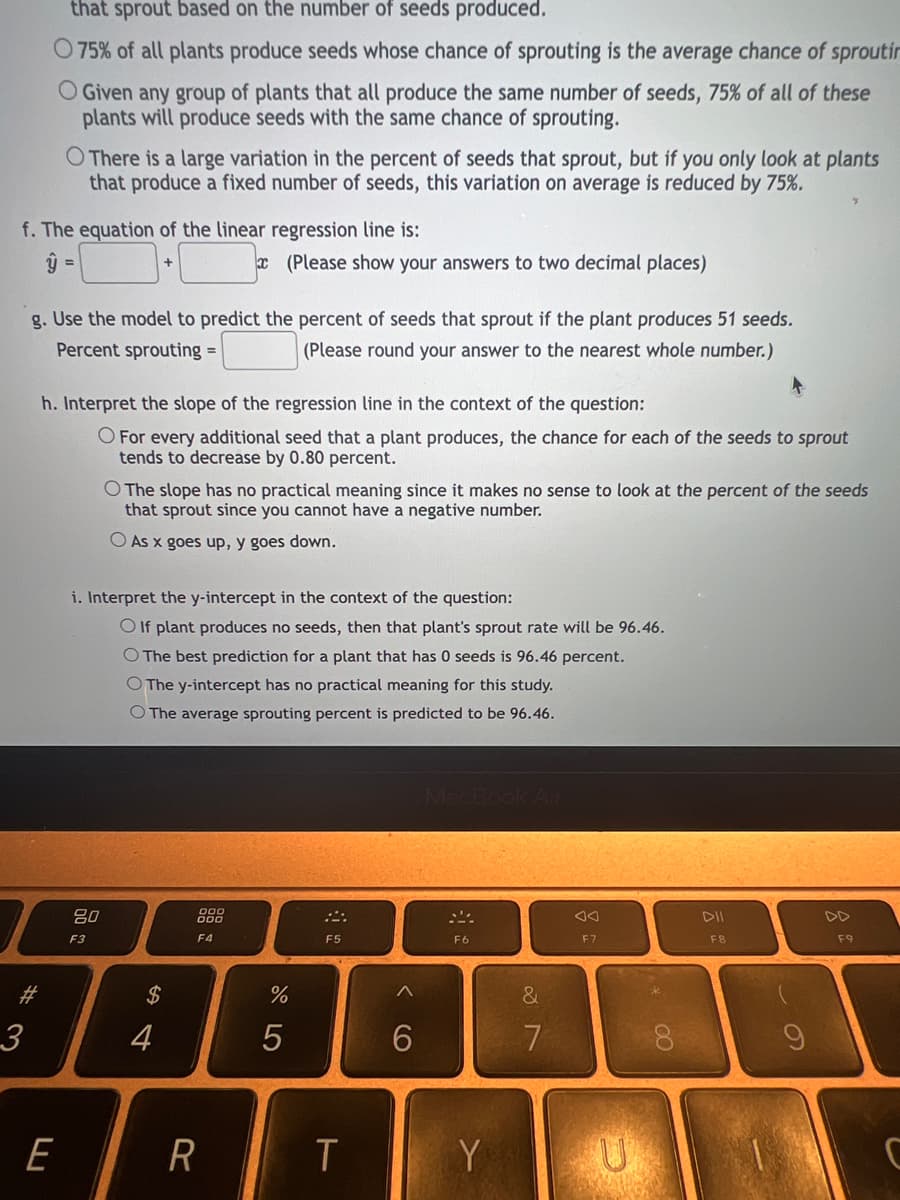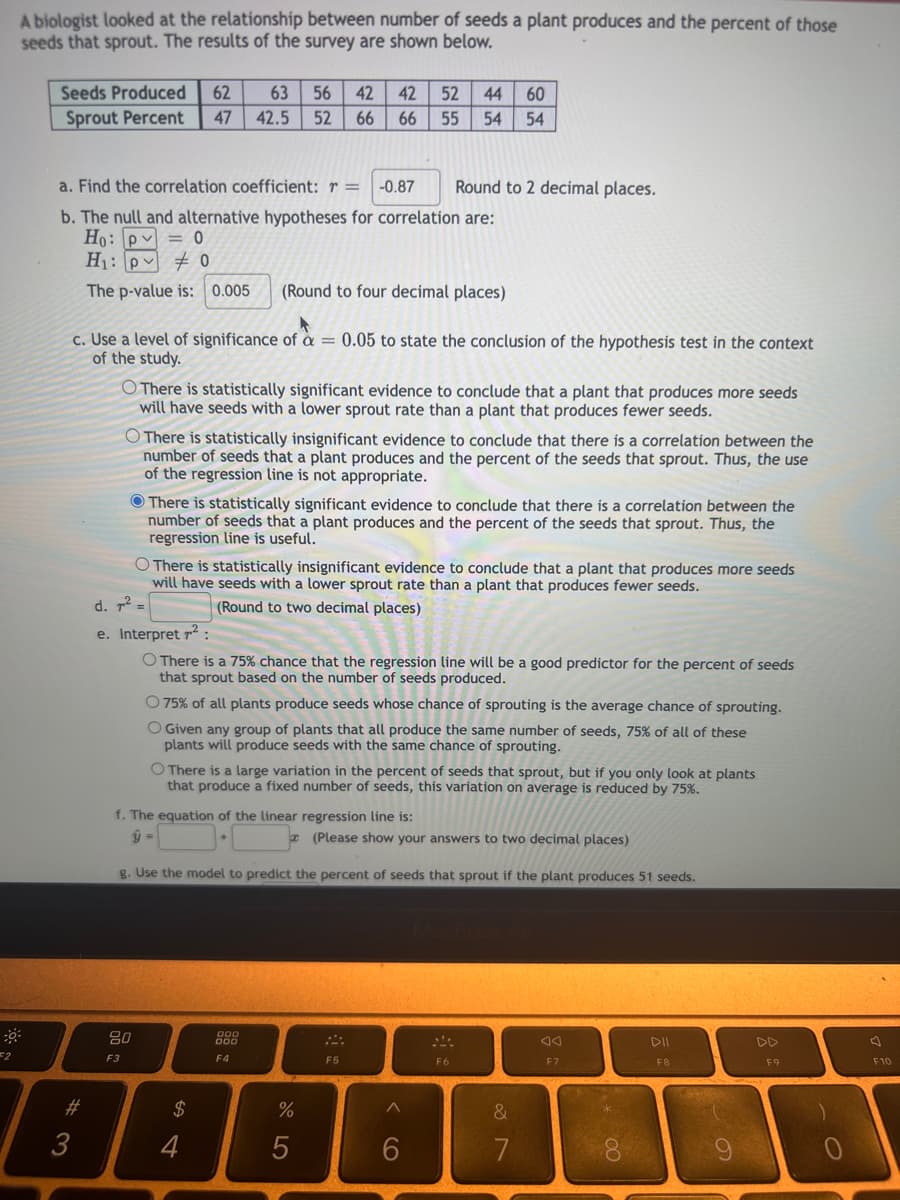d. 2. M (Round to two decimal places) wer seeds. e. Interpret ²: O There is a 75% chance that the regression line will be a good predictor for the percent of see- that sprout based on the number of seeds produced. O 75% of all plants produce seeds whose chance of sprouting is the average chance of sprouting_ Given any group of plants that all produce the same number of seeds, 75% of all of these plants will produce seeds with the same chance of sprouting. O There is a large variation in the percent of seeds that sprout, but if you only look at plants that produce a fixed number of seeds, this variation on average is reduced by 75%. f. The equation of the linear regression line is:
d. 2. M (Round to two decimal places) wer seeds. e. Interpret ²: O There is a 75% chance that the regression line will be a good predictor for the percent of see- that sprout based on the number of seeds produced. O 75% of all plants produce seeds whose chance of sprouting is the average chance of sprouting_ Given any group of plants that all produce the same number of seeds, 75% of all of these plants will produce seeds with the same chance of sprouting. O There is a large variation in the percent of seeds that sprout, but if you only look at plants that produce a fixed number of seeds, this variation on average is reduced by 75%. f. The equation of the linear regression line is:
Glencoe Algebra 1, Student Edition, 9780079039897, 0079039898, 2018
18th Edition
ISBN:9780079039897
Author:Carter
Publisher:Carter
Chapter4: Equations Of Linear Functions
Section4.5: Correlation And Causation
Problem 15PPS
Related questions
Question
Please solve what’s left thank you

Transcribed Image Text:that sprout based on the number of seeds produced.
75% of all plants produce seeds whose chance of sprouting is the average chance of sproutin
O Given any group of plants that all produce the same number of seeds, 75% of all of these
plants will produce seeds with the same chance of sprouting.
f. The equation of the linear regression line is:
# 3
O There is a large variation in the percent of seeds that sprout, but if you only look at plants
that produce a fixed number of seeds, this variation on average is reduced by 75%.
g. Use the model to predict the percent of seeds that sprout if the plant produces 51 seeds.
Percent sprouting =
(Please round your answer to the nearest whole number.)
E
h. Interpret the slope of the regression line in the context of the question:
O For every additional seed that a plant produces, the chance for each of the seeds to sprout
tends to decrease by 0.80 percent.
80
i. Interpret the y-intercept in the context of the question:
O If plant produces no seeds, then that plant's sprout rate will be 96.46.
O The best prediction for a plant that has 0 seeds is 96.46 percent.
O The y-intercept has no practical meaning for this study.
O The average sprouting percent
is predicted to be 96.46.
F3
O The slope has no practical meaning since it makes no sense to look at the percent of the seeds
that sprout since you cannot have a negative number.
As x goes up, y goes down.
$
(Please show your answers to two decimal places)
4
888
F4
R
do LO
%
5
܀
F5
T
<
6
MacBook Air
F6
Y
&
7
F7
U
** 00
DII
F8
9
F9

Transcribed Image Text:€2
A biologist looked at the relationship between number of seeds a plant produces and the percent of those
seeds that sprout. The results of the survey are shown below.
Seeds Produced 62 63 56 42 42 52 44 60
Sprout Percent 47 42.5 52 66 66 55 54 54
a. Find the correlation coefficient: r = -0.87
b. The null and alternative hypotheses for correlation are:
Ho: p = 0
H₁: p0
The p-value is: 0.005 (Round to four decimal places)
c. Use a level of significance of a = 0.05 to state the conclusion of the hypothesis test in the context
of the study.
#3
3
O There is statistically significant evidence to conclude that a plant that produces more seeds
will have seeds with a lower sprout rate than a plant that produces fewer seeds.
There is statistically insignificant evidence to conclude that there is a correlation between the
number of seeds that a plant produces and the percent of the seeds that sprout. Thus, the use
of the regression line is not appropriate.
There is statistically significant evidence to conclude that there is a correlation between the
number of seeds that a plant produces and the percent of the seeds that sprout. Thus, the
regression line is useful.
80
F3
O There is statistically insignificant evidence to conclude that a plant that produces more seeds
will have seeds with a lower sprout rate than a plant that produces fewer seeds.
(Round to two decimal places)
d. 2
e. Interpret ²:
O There is a 75% chance that the regression line will be a good predictor for the percent of seeds
that sprout based on the number of seeds produced.
O 75% of all plants produce seeds whose chance of sprouting is the average chance of sprouting.
O Given any group of plants that all produce the same number of seeds, 75% of all of these
plants will produce seeds with the same chance of sprouting.
f. The equation of the linear regression line is:
ŷ=
O There is a large variation in the percent of seeds that sprout, but if you only look at plants
that produce a fixed number of seeds, this variation on average is reduced by 75%.
g. Use the model
Round to 2 decimal places.
$
4
000
F4
(Please show your answers to two decimal places)
redict the percent of seeds that sprout if the plant produces 51 seeds.
%
5
F5
A
F6
&
7
8:
F7
***00
DII
F8
F9
F10
Expert Solution
This question has been solved!
Explore an expertly crafted, step-by-step solution for a thorough understanding of key concepts.
Step by step
Solved in 2 steps

Recommended textbooks for you

Glencoe Algebra 1, Student Edition, 9780079039897…
Algebra
ISBN:
9780079039897
Author:
Carter
Publisher:
McGraw Hill

Big Ideas Math A Bridge To Success Algebra 1: Stu…
Algebra
ISBN:
9781680331141
Author:
HOUGHTON MIFFLIN HARCOURT
Publisher:
Houghton Mifflin Harcourt


Glencoe Algebra 1, Student Edition, 9780079039897…
Algebra
ISBN:
9780079039897
Author:
Carter
Publisher:
McGraw Hill

Big Ideas Math A Bridge To Success Algebra 1: Stu…
Algebra
ISBN:
9781680331141
Author:
HOUGHTON MIFFLIN HARCOURT
Publisher:
Houghton Mifflin Harcourt
